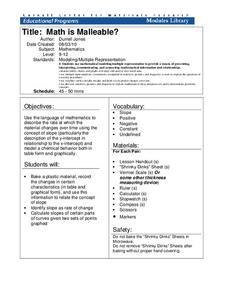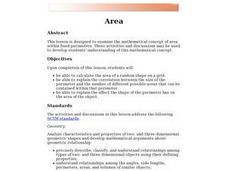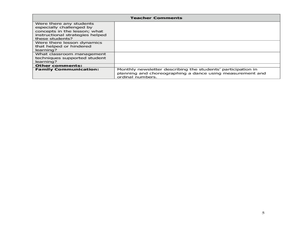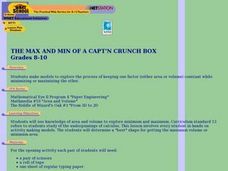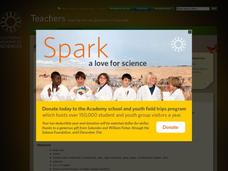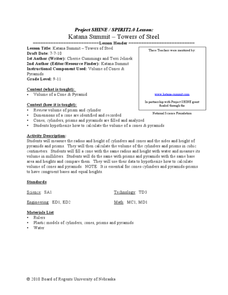Virginia Department of Education
Weather Patterns and Seasonal Changes
Get your class outside to observe their surroundings with a lesson highlighting weather patterns and seasonal changes. First, learners take a weather walk to survey how the weather affects animals, people, plants, and trees during...
Virginia Department of Education
Heat and Thermal Energy Transfer
How does radiation affect our daily lives? Answer that question and others with a lesson that discusses radiation and its use in thermal energy transfer through electromagnetic waves. Pupils investigate vaporization and...
Cornell University
Math Is Malleable?
Learn about polymers while playing with shrinky dinks. Young scholars create a shrinky dink design, bake it, and then record the area, volume, and thickness over time. They model the data using a graph and highlight the key features of...
Curated OER
Area Applet
Elementary math classes calculate the area of a shape and explain the correlation between the size of the perimeter and the areas that can be contained within that perimeter. They also explain the effect the shape of the perimeter has on...
Curated OER
Dance and Math
Second graders examine human body movements by measuring the choreography of a dance. In this physical education lesson plan, 2nd graders participate in a creative dance which is based on specific movements of each limb, which...
Curated OER
And You Thought Gasoline Was Expensive!
Students carry out a cost analysis. In this comparative math lesson, students compare the cost of equal measures of gasoline to mouthwash, house paint, fruit juice, white-out, and other liquids.
Curated OER
the Max And Min of a Capt'n Crunch Box
Students use knowledge of area and volume to explore minimum and maximum. They create models and determine a "best" shape for getting the maximum volume or minimum area.
Curated OER
A Cylinder Workshop
Students work with given formulas to solve for specific variables. The calculation of the volume of a cylinder and the change in volume when there is a constant surface area is analyzed in this lesson.
Curated OER
Length and Area
Fourth graders measure one centimeter cubed blocks to determine their size. They measure lines using a worksheet that is not included in the activity. Next, they measure the area of figures on the sheet using the cubes in place of a ruler.
Curated OER
NON-EUCLIDEAN GEOMETRY.
Young scholars study relationships between angles, side lengths, perimeters, areas and volumes of similar objects. In this lesson students also create and critique inductive and deductive arguments concerning congruency, similarity and...
Curated OER
Commutative Property
First graders use various models to learn the Commutative Property of Addition. In this Commutative Property lesson, 1st graders use other students, counters, balances, and dominoes to apply the addition property. Students solve addition...
California Academy of Science
Greening Your Middle School
Middle schoolers redesign their school to make it more energy efficient, and create a model of their design. Learners get together in groups of 5, and they take on the task of making their school more energy efficient. To do this, they...
Curated OER
Towers of Steel
This lesson starts with geometers discussing how to find the volume of a cone and pyramid, using what they know about the volume of a cylinder or prism. Then, using the formulas, they calculate the volume of cones and...
Curated OER
Water Displacement to Determine Volume
Sixth graders explore the water displacement method to determine the volume of solid objects such as rocks, nails, and marbles.
Curated OER
Elementary Exploration: Liquids
Students study the attributes of liquids. In this science exploration activity, students participate in a hands-on activity that requires them to examine the volume and shape of liquid.
Curated OER
How Do Your Students Measure Up?
Students participate in a paper folding activity that has them create a ruler for measuring to the closest 1/16th of an inch.
Curated OER
Introduction to Measuring the Forest
Students investigate how much wood is in a forest. For this forestry lesson, students calculate how much usable wood comes from the forest. They will read, Sizing Things Up from Trees + Me = Forestry, measure firewood piles, and create a...
Curated OER
Reading Equipment with Scales
Students examine the metric system and practice reading several different measuring devices. In this investigative lesson students participate in an activity that helps them know the metric system.
Curated OER
temperature and the Scientific Method Lesson Plan
Sixth graders study heat, temperature, and heat transfer. Using probeware, the teacher demonstrates boiling points. Students participate in experiments and record the beginning and ending temperatures and mass of objects. After...
Nuffield Foundation
Measuring the Rate of Metabolism
Plant respiration can be a difficult concept for young biologists to grasp; with a hands-on lab, learners can collect and graph data, then calculate the metabolism rate for the plants they studied. If you do not have a respirometer,...
Laboratory for Atmospheric and Space Physics
Jupiter’s Relative Size
How do you properly illustrate the extreme size difference between two planets—Earth and Jupiter? With the help of jellybeans, of course! Create a scale model of Jupiter's mass compared to Earth using a fishbowl, 1,400 beans, and a...
Nuffield Foundation
Measuring the Vitamin C Content of Foods and Fruit Juices
Are you getting enough vitamin C? Young scientists determine the amount of vitamin C in fruit juice samples. They accomplish this task by adding DCPIP solution to the samples until the blue color of the DCPIP persists. Once this happens,...
EngageNY
Logarithms—How Many Digits Do You Need?
Forget your ID number? Your pupils learn to use logarithms to determine the number of digits or characters necessary to create individual ID numbers for all members of a group.


